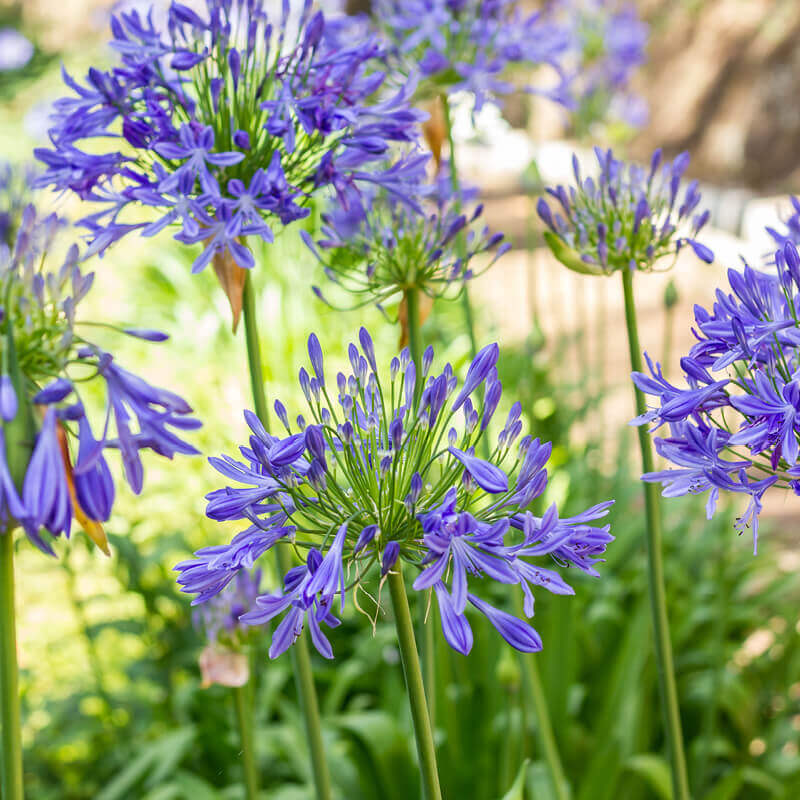How to Plant and Maintain Agapanthus in Your Yard
Understanding the Art of Agapanthus Treatment: Crucial Actions for Healthy And Balanced Development and Lively Flowers
In the world of gardening, the cultivation of agapanthus stands as a satisfying endeavor for those who look for to support these classy blooming plants. With their striking flowers and graceful foliage, agapanthus has actually recorded the interest of gardeners worldwide. Nonetheless, attaining ideal growth and lively blossoms needs a nuanced strategy that incorporates different necessary steps. From picking the appropriate range to mastering pruning methods, the trip in the direction of growing growing agapanthus plants is complex and holds the key to unlocking the full potential of these organic treasures.

Selecting the Right Agapanthus Variety

When selecting the appropriate Agapanthus variety for your garden, consider factors such as climate viability, blossom shade, and development habit. Agapanthus, commonly referred to as Lily of the Nile or African lily, can be found in a range of colors varying from shades of blue and purple to white. Select a flower color that matches your existing garden scheme to produce a harmonious landscape. In addition, think about the environment in your region to make sure the Agapanthus variety you choose can grow in your specific problems. Some varieties are much more tolerant of cool temperatures, while others like warmer climates. Comprehending the growth habit of different Agapanthus varieties is vital for proper placement within your garden. Some selections have a clumping growth habit, ideal for boundaries or containers, while others have an even more dispersing nature, appropriate for ground cover or mass plantings. By meticulously evaluating these variables, you can pick the excellent Agapanthus selection to improve the beauty of your garden.
Ideal Planting Problems
Thinking about the ideal environmental demands is vital for successful Agapanthus farming. Agapanthus grows in well-draining dirt with a slightly acidic to neutral pH degree. When planting, choose a place that receives complete sunshine to partial shade. In hotter environments, offering some afternoon shade can protect against scorching of the fallen leaves. Agapanthus plants are sensitive to cool temperatures and must be safeguarded from frost throughout winter months.
To guarantee healthy growth and vibrant blossoms, plant Agapanthus light bulbs at a deepness of concerning 2-4 inches and room them 8-12 inches apart. Mulching around the base of the plants aids retain dampness and suppresses weed growth.
Watering and Feeding Tips
Maintaining appropriate moisture levels and offering essential nutrients are crucial elements in description the treatment routine for Agapanthus plants. When it comes to watering Agapanthus, it is important to strike a balance. These plants like consistently damp soil but are susceptible to root rot if overwatered.
Fertilizing Agapanthus is crucial for advertising healthy and balanced development and respected flowers. Use a balanced fertilizer, such as a 10-10-10 formula, in the very early springtime as brand-new development emerges. By adhering to these watering and feeding suggestions, you can ensure your Agapanthus plants prosper and generate vivid, durable blossoms.
Pruning Techniques for Agapanthus
Pruning Agapanthus plants at the suitable times and with correct strategies is critical for keeping their health and wellness and promoting optimum growth and flowering. The excellent time to trim Agapanthus is in late winter season or very early spring before brand-new growth emerges.
Deadheading invested blossoms can likewise redirect the plant's energy into creating even more blossoms rather than establishing seeds. If you want to accumulate seeds for propagation, leave some blossoms to fully grown and completely dry on the plant.
Keep in mind to read this article utilize tidy, sharp devices to make specific cuts and reduce the danger of introducing illness. Agapanthus. Routine trimming will certainly help keep your Agapanthus looking healthy and balanced and neat while making certain a bountiful screen of gorgeous flowers
Managing Usual Insects and Illness
After guaranteeing correct pruning methods for Agapanthus, it is important to deal with common pests and illness that can influence the wellness and vigor of these plants. One typical bug that influences Agapanthus is the Agapanthus gall midge.
In addition, Agapanthus plants can experience from root rot if they are planted in improperly draining soil. By being attentive and taking timely activity against conditions and parasites, you can help your Agapanthus plants prosper and create lively blossoms. Agapanthus.

Verdict
Finally, mastering the art of agapanthus treatment entails choosing the best variety, giving excellent growing conditions, proper watering and feeding, appropriate trimming techniques, and attending to typical pests and diseases. By adhering to these important steps, you can make certain healthy development and vibrant blooms for your agapanthus plants. Keep in mind to regularly keep track of and preserve your plants to promote their total well-being and long life.
To make sure healthy growth and vivid blossoms, plant Agapanthus bulbs at a deepness of regarding 2-4 inches and room them 8-12 inches apart. By following these watering and feeding suggestions, you can guarantee your Agapanthus plants prosper and create lively, durable blossoms.
One usual parasite that affects Agapanthus is the Agapanthus gall midget. In addition, Agapanthus plants can endure from root rot why not try these out if they are grown in inadequately draining dirt. By adhering to these essential steps, you can make sure healthy and balanced development and vibrant flowers for your agapanthus plants.